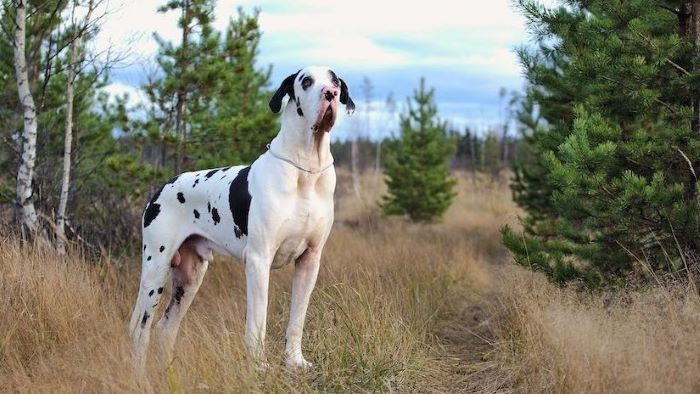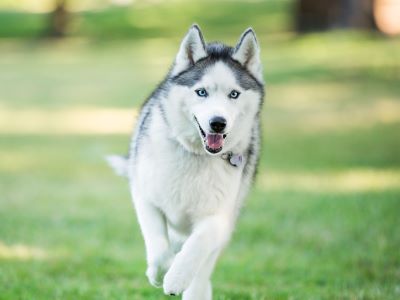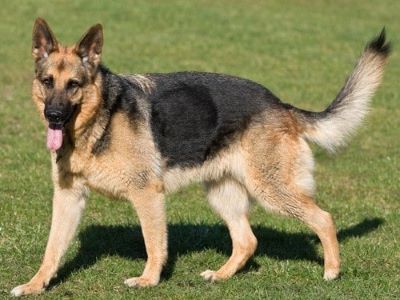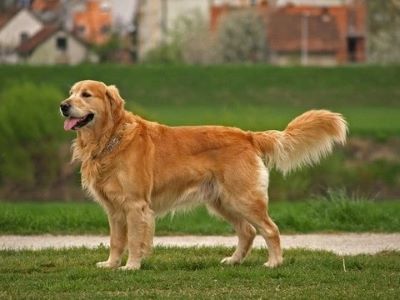When it comes to man’s best friend, looks can be deceiving. Some breeds like the Great Dane are surely giant, but their brain size is not the same. So “How big is a dog’s brain?”

Dogs can be different sizes but their brains are not. Imagine the Great Dane with his small orange-sized brain, crazy right? Let’s dive into dogs’ brains and learn more about their mysterious mind and whether or not they think about only food all day, stay tuned to find out!
How Big Is a Dog’s Brain?
A dog’s brain is about the size of a small orange, like a tangerine. That’s much smaller than a human’s brain. Dogs have feelings like happiness, fear, anger, excitement and pain, similar to humans. But dogs can’t experience more complicated emotions than humans can.
Not all dog breeds have the same brain size. For example, a little Chihuahua’s brain is way smaller than a big German Shepherd’s brain.
Dog brains come in different sizes, much smaller than those big human brains. It’s like comparing a tiny pebble to a huge boulder. Inside a dog’s head, there are three major regions doing all the thinking, balancing, and life-keeping stuff, let’s see them in detail[1]:
- Cerebral Cortex: Imagine the cerebral cortex as the ‘thinking hat‘ of a dog. This part helps them make sense of the world. It’s like their own mini-computer, processing information and making decisions.
- Cerebellum: Now, picture the cerebellum as the ‘balance boss‘. It’s in charge of making sure a dog doesn’t trip over their own paws. This part is all about keeping their balance and making their movements smooth, like a graceful dancer.
- Brainstem: Lastly, meet the brainstem – the ‘control centre‘. This part takes care of all the vital functions, like breathing and keeping the heart ticking. It’s like the superhero inside, silently saving the day.

Dog brains are like small pebbles compared to the human brain, which is like a gigantic boulder. It’s a ‘David and Goliath’ situation in the world of brains.
The Function of a Dog’s Brain
A dog’s brain handles a lot, even though it’s small! One of the main works is processing sensory information to understand everything around them. The brain takes in smells, sights, sounds, and other senses.
Another main function is controlling the dog’s balance in movement, the brain sends signals to the body on how to move. The brain also manages functions like learning, memory and problem-solving. Their brain gives dogs intelligent thinking skills.
Finally, a dog’s brain enables emotional and social skills. It produces feelings like happiness, fear, love and anger. And it allows dogs to bond with humans and other dogs.
So the dog’s small but powerful brain handles everything from smell to emotions. Their little lemon-sized brain lets dogs fully experience life!

Factors Influencing Brain Size
Bigger dog brains don’t always mean smarter dogs.
- Some dog breeds are like the brainiacs of the dog world. Border Collies, Poodles, and German Shepherds are among the cleverest. They’ve got both the brain size and the smarts to tackle tricky tasks.
- Smaller dogs like Papillons and Poodles can be very intelligent and solve problems. Bigger dogs like Mastiffs have larger brains but may not be as smart.
- Medium dogs have balanced, versatile brains. Large dogs have bigger brains to control their extensive bodies. Specific breeds also have unique brains.
- Some breeds have unusual brain adaptations. For example, scent hounds like Bloodhounds have large olfactory parts of the brain, making them excellent at tracking scents.
Each breed’s history shaped its brains.
Health Implications of Brain Size
Just like humans dogs with very large or small brains may face the risk of neurological problems. Brain size can also affect a dog’s overall health and how long they live.
Different comes with different sets of considerations. Regular check-ups with a vet can be helpful in this case as they can detect and manage any issues that may arise.

Comparing Dog Brain Size to Other Animals
A study by a university in Hungary found modern dog breeds actually have bigger brains than ancient breeds from thousands of years ago. Dogs have more neurons in their cerebral cortex compared to cats. But dog brains are still smaller than human brains.
The cerebral cortex, the largest brain part, is very different in humans versus dogs. Dogs can feel excited, scared, angry, happy and in pain just like people do. But dogs probably can’t experience complicated feelings that humans have.
When you compare dogs to other animals, it shows the amazing diversity in the animal kingdom’s brains, let’s see in detail:
- Cats: In the domestic pet world, cats are often seen as the rivals of dogs. When it comes to brain size, dogs usually have the upper paw, but cats are quite clever in their own right. They’ve got a different style of thinking, focusing more on skillfulness.
- Horses: Horses are renowned for their beauty and strength, but in the brain department, dogs surpass them. Horses have bigger brains than dogs, but they use them differently. Horses rely on their massive brains for survival skills, while dogs lean more towards social intelligence.
- Rabbits: Compared to dogs, rabbits have relatively small brains. However, their brains are wired for quick reactions and evasive manoeuvres, important for staying safe in the wild.
- Wolves: Wolves are known for their sharp hunting skills, but domesticated dogs have adapted their brains to work better with humans.
- Foxes: Foxes are clever and adaptable in the wild, with brain sizes that are on par with dogs. However, their brains serve different purposes in the wild, where they’re cunning hunters and scavengers.

Do Dogs Have Dreams and Nightmares?
If you ever notice your dog in his sleep moving paws and body in such a way that they are trying to run then yes, they are dreaming. Probably chasing that squirrel down the tree, playing fetch with you and if it’s anywhere around their eating time they are surely dreaming about food.
While dogs dream about fun activities, unfortunately, they may also experience nightmares. They may cry or growl due to bad dreams, but make them feel safe as they wake up.
FAQs
What Does a Dog Think About All Day?
Overall, dogs are complex creatures that think about a wide range of things, including social relationships, their physical environment, daily routine, physical needs, and health and well-being.
How Big Is a Dog’s Brain?
Most dogs’ brains are roughly the size of a lemon, tangerine, or any other small to medium-sized citrus fruit. You do have to take into account dog breeds along with the pet’s size. For instance, Labrador Retrievers or Border Collies are larger domestic dogs, allowing more space for a big brain.
Is a Dog Brain Bigger Than a Human Brain?
The brains of dogs are smaller than humans in relation to overall body size. In humans, the brain-to-body ratio is 1:40 while in dogs it’s 1:125. The brains of humans have more folds, which means more surface area. The cortex of dogs is smaller and has fewer folds.
Why Do Dogs Stare at You?
Most dog staring is a combination of affection and attention. While it may make you uncomfortable, your dog is most likely fascinated by you. So rather than discouraging that human-centric focus, you can make it work for both of you.
Conclusion
In conclusion “How big is a dog’s brain?” Dogs have tiny tangerine-sized brains compared to our big human brains. But don’t underestimate what that small lemon lump in your dog’s head can do!
Scientists are still learning about our dog’s little heads. But one thing’s for sure, dogs are 100% good boys and girls, even with their teeny tiny brains. Their loyalty and love are bigger than any brain science can explain!
So the next time you find your dog wagging tail you remind yourself their brains are small but their hearts are humongous!
Reference:
- Dogs Have the Most Neurons, Though Not the Largest Brain: Trade-Off between Body Mass and Number of Neurons in the Cerebral Cortex of Large Carnivoran Species. Frontiers in Neuroanatomy



